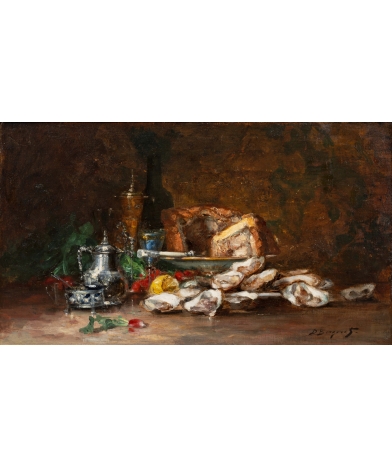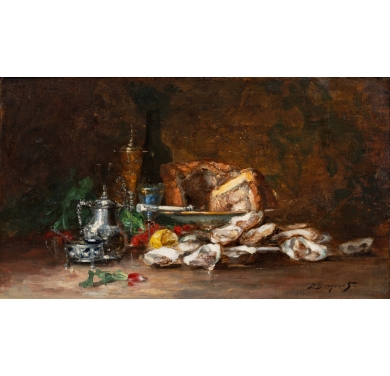Pierre Denis Bergeret (1846-1910) - The Festive meal
Oil on canvas signed lower right
Dimensions : H. 40 x W. 70 cm (With frame: H. 74 x W. 104 cm)
Denis Bergeret was a French painter born in 1844 and died in 1910. He followed in the purest classical tradition, having been taught by the greatest masters of the time, Eugène Isabey, Jules Lefebvre and Léon Bonnat. As early as 1870, when he was just 21, he began exhibiting at the official Paris Salon, where he remained until 1908.
He died prematurely, leaving a relatively small body of work, all the rarer for the fact that a large number of his paintings were acquired by museums in France, Switzerland and Belgium: Bernay, Ghent, Geneva, Pau, Rouen, Château de Malmaison, Charenton-le-pont... and above all, a very fine still life preserved by the Musée d'Orsay in Paris. Bergeret's brushstrokes are lively and thick, and his colors are luminous, making his works sensual and gourmand. Highly appreciated during his lifetime, Bergeret was made a knight of the Légion d'honneur in 1900.
Our still life is a good size, whereas Pierre Denis Bergeret often favored smaller dimensions. The original composition is particularly successful. The artist has opted for a compact, pyramid-shaped composition, skilfully organized. The palette is particularly rich. The eye is drawn to the center of the painting by the blue of a glass, which joins the green and red of the radishes and the yellow of the lemon. These powerful, bold colors stand out against a dark background. With flat areas of white, the artist manages to suggest the milky, pearly appearance of the oysters. The painting is full of substance, especially the background, which is far from plain, combining greens, browns and ochres. With this magnificent work, Bergeret places himself on a par with Guillaume Fouace, another great specialist in culinary subjects. The atmosphere and spirit of Chardin are not far away.
This work is in absolutely perfect condition, on its original canvas. The thick material is intact, and there are no signs of overpainting. The painting is still in its rich wood and gilded stucco frame, which has been perfectly restored.






